
Vaccinium vitis-idaea is a small evergreen shrub in the heath family Ericaceae, known colloquially as the lingonberry, partridgeberry, foxberry, mountain cranberry, or cowberry. It is native to boreal forest and Arctic tundra throughout the Northern Hemisphere, including Eurasia and North America. Commercially cultivated in the United States Pacific Northwest and the Netherlands, the edible berries are also picked in the wild and used in various dishes, especially in Nordic cuisine.

Antennaria is a genus of dioecious perennial herbs in the family Asteraceae, native to temperate regions of the Northern Hemisphere, with a few species in temperate southern South America; the highest species diversity is in North America. Common names include catsfoot or cat's-foot, pussytoes and everlasting.
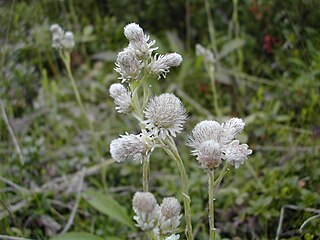
Antennaria alpina is a European and North American species of plant in the family Asteraceae. Antennaria alpina is native to mountainous and subarctic regions of Scandinavia, Greenland, Alaska, and the Canadian Arctic, extending south at high altitudes in mountains in the Rocky Mountains south to Montana and Wyoming.

Acer glabrum is a species of maple native to western North America, from southeastern Alaska, British Columbia and western Alberta, east to western Nebraska, and south through Washington, Oregon, Idaho, Montana and Colorado to California, Arizona, Utah, and New Mexico.
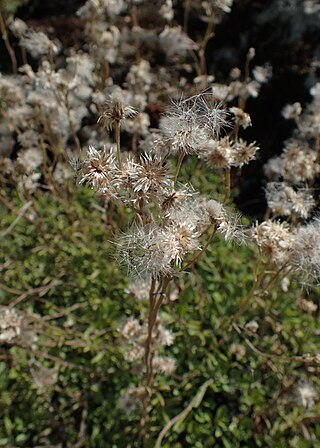
Antennaria howellii, the everlasting or Howell's pussytoes, is a North American species of plant in the family Asteraceae. It is native to northern Alaska, much of Canada including the Arctic territories, and the northern United States as far south as northern California, Colorado and North Carolina.

Apocynum androsaemifolium, the fly-trap dogbane or spreading dogbane, is a flowering plant in the Gentianales order. It is common across Canada and much of the United States excepting the deep southeast.
The native flora of the United States includes about 17,000 species of vascular plants, plus tens of thousands of additional species of other plants and plant-like organisms such as algae, lichens and other fungi, and mosses. About 3,800 additional non-native species of vascular plants are recorded as established outside of cultivation in the U.S., as well as a much smaller number of non-native non-vascular plants and plant relatives. The United States possesses one of the most diverse temperate floras in the world, comparable only to that of China.

Clintonia uniflora, commonly known as bride's bonnet, queen's cup, or bead lily, is a species of flowering plant in the lily family Liliaceae. The specific epithet uniflora means "one-flowered", a characteristic that distinguishes this species from others in the genus Clintonia. For this reason, it is also known as the single-flowered clintonia.

Tephroseris palustris, also known by its common names swamp ragwort, northern swamp groundsel, marsh fleabane, marsh fleawort, clustered marsh ragwort and mastodon flower, a herbaceous species of the family Asteraceae. It can be seen most easily when its bright yellow umbel flowers appear from May to early July standing 3 to 4 feet along marshes, stream banks and slough areas where it likes to grow.

Antennaria media is a North American species of flowering plants in the family Asteraceae known by the common name Rocky Mountain pussytoes. It is native to western Canada and the Western United States from Alaska and Yukon Territory to California to New Mexico. It grows in cold Arctic and alpine regions, either at high latitudes in the Arctic or at high elevations in the mountains.

Antennaria rosea is a North American species of flowering plant in the family Asteraceae known by the common name rosy pussytoes. Other common names include cat's foot and mountain everlasting. The second part of its scientific name, rosea, is Latin for pink.
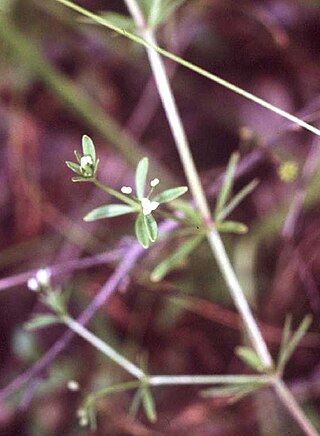
Galium trifidum is a species of flowering plant in the coffee family, known by the common name three-petal bedstraw. It grows widespread in the arctic, temperate and subtropical regions of the Northern Hemisphere: northern and central Asia, northern and eastern Europe and much of North America.
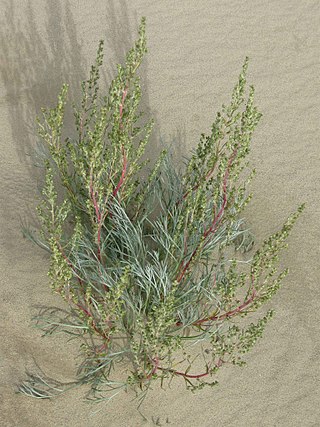
Artemisia campestris subsp. borealis is an arctic and alpine subspecies of plant in the sunflower family, commonly known as northern wormwood, boreal sage, boreal wormwood or boreal sagewort. It is native to high latitudes and high elevations in Eurasia and North America. In North America, it can be found in Alaska, Greenland, the Canadian Arctic, and the Rockies, Cascades, and Sierra Nevada as far south as Arizona and New Mexico. In Eurasia, it is widespread across European and Asiatic Russia and also grows in Scandinavia and in the mountains of central Europe
Antennaria densifolia, the denseleaf pussytoes, is a North American species of plants in the family Asteraceae. It is native to western Canada and the US states of Alaska and Montana. It grows in subalpine-alpine limestone talus.
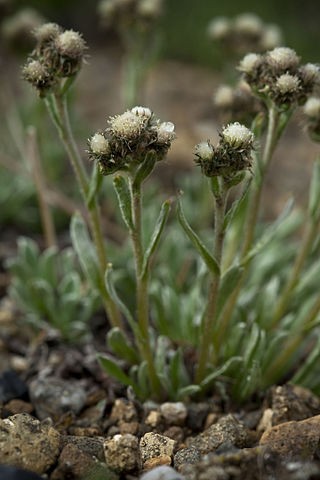
Antennaria friesiana, or Fries' pussytoes, is an Arctic species of plants in the family Asteraceae. It is the northern reaches of Asia and North America. Many of the populations lack male (staminate) flowers and reproduce asexually.

Antennaria lanata is a North American species of flowering plant in the family Asteraceae, known by the common name woolly pussytoes. It is native to western Canada and the northwestern United States.
Antennaria pulchella is a North American species of flowering plants in the family Asteraceae known by the common names showy pussytoes and handsome pussytoes. It is widespread across much of Canada including the three Arctic Territories, as well as in parts of the United States.
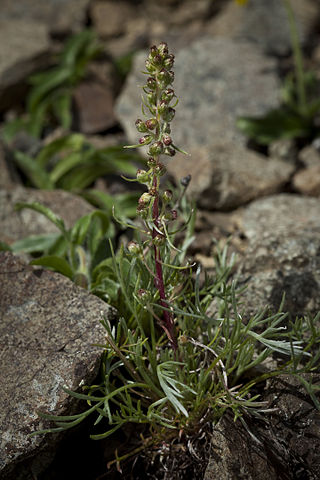
Artemisia furcata, the forked wormwood, is an Asian and North American species of plant in the sunflower family Asteraceae found in cold regions at high elevations or high latitudes.

Boykinia richardsonii is a species of flowering plant in the family Saxifragaceae, endemic to Alaska and the adjacent Canadian territory of Yukon. It is commonly known as Richardson's brookfoam, but has also been called Alaska boykin, bearflower, Richardson's boykin and Richardson's saxifrage. "Bearflower" reflects its popularity with grizzly bears as forage in the summer months when it flowers.

















